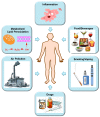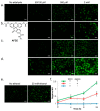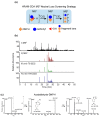Bioanalytical and Mass Spectrometric Methods for Aldehyde Profiling in Biological Fluids
- PMID: 31167424
- PMCID: PMC6630274
- DOI: 10.3390/toxics7020032
Bioanalytical and Mass Spectrometric Methods for Aldehyde Profiling in Biological Fluids
Abstract
Human exposure to aldehydes is implicated in multiple diseases including diabetes, cardiovascular diseases, neurodegenerative disorders (i.e., Alzheimer's and Parkinson's Diseases), and cancer. Because these compounds are strong electrophiles, they can react with nucleophilic sites in DNA and proteins to form reversible and irreversible modifications. These modifications, if not eliminated or repaired, can lead to alteration in cellular homeostasis, cell death and ultimately contribute to disease pathogenesis. This review provides an overview of the current knowledge of the methods and applications of aldehyde exposure measurements, with a particular focus on bioanalytical and mass spectrometric techniques, including recent advances in mass spectrometry (MS)-based profiling methods for identifying potential biomarkers of aldehyde exposure. We discuss the various derivatization reagents used to capture small polar aldehydes and methods to quantify these compounds in biological matrices. In addition, we present emerging mass spectrometry-based methods, which use high-resolution accurate mass (HR/AM) analysis for characterizing carbonyl compounds and their potential applications in molecular epidemiology studies. With the availability of diverse bioanalytical methods presented here including simple and rapid techniques allowing remote monitoring of aldehydes, real-time imaging of aldehydic load in cells, advances in MS instrumentation, high performance chromatographic separation, and improved bioinformatics tools, the data acquired enable increased sensitivity for identifying specific aldehydes and new biomarkers of aldehyde exposure. Finally, the combination of these techniques with exciting new methods for single cell analysis provides the potential for detection and profiling of aldehydes at a cellular level, opening up the opportunity to minutely dissect their roles and biological consequences in cellular metabolism and diseases pathogenesis.
Keywords: aldehydes; biological fluids; cancer; data-dependent profiling; derivatization; diseases; exposure biomarkers; genotoxicity; high-resolution mass spectrometry; isotope labeling; oxidative stress.
Conflict of interest statement
The authors declare no conflict of interest.
Figures







Similar articles
-
[Recent advances in chemical derivatization-based chromatography-mass spectrometry methods for analysis of aldehyde biomarkers].Se Pu. 2021 Aug;39(8):845-854. doi: 10.3724/SP.J.1123.2021.02023. Se Pu. 2021. PMID: 34212585 Free PMC article. Chinese.
-
Mass spectrometry for detection of 4-hydroxy-trans-2-nonenal (HNE) adducts with peptides and proteins.Mass Spectrom Rev. 2004 Jul-Aug;23(4):281-305. doi: 10.1002/mas.10076. Mass Spectrom Rev. 2004. PMID: 15133838 Review.
-
Stable isotope labeling by fatty acids in cell culture (SILFAC) coupled with isotope pattern dependent mass spectrometry for global screening of lipid hydroperoxide-mediated protein modifications.J Proteomics. 2017 Aug 23;166:101-114. doi: 10.1016/j.jprot.2017.07.006. Epub 2017 Jul 20. J Proteomics. 2017. PMID: 28735093
-
Profiling of carbonyl compounds in serum by stable isotope labeling - Double precursor ion scan - Mass spectrometry analysis.Anal Chim Acta. 2017 May 15;967:42-51. doi: 10.1016/j.aca.2017.03.006. Epub 2017 Mar 20. Anal Chim Acta. 2017. PMID: 28390484
-
Isotope-coded ESI-enhancing derivatization reagents for differential analysis, quantification and profiling of metabolites in biological samples by LC/MS: A review.J Pharm Biomed Anal. 2016 Oct 25;130:181-193. doi: 10.1016/j.jpba.2016.04.033. Epub 2016 Apr 30. J Pharm Biomed Anal. 2016. PMID: 27178301 Review.
Cited by
-
Enzymatic Synthesis of Diverse Heterocycles by a Noncanonical Nonribosomal Peptide Synthetase.ACS Chem Biol. 2021 Dec 17;16(12):2776-2786. doi: 10.1021/acschembio.1c00623. Epub 2021 Nov 12. ACS Chem Biol. 2021. PMID: 34767712 Free PMC article.
-
4-Hydroxy-2-nonenal, a lipid peroxidation product, as a biomarker in diabetes and its complications: challenges and opportunities.Free Radic Res. 2021 May;55(5):547-561. doi: 10.1080/10715762.2020.1866756. Epub 2021 Jan 7. Free Radic Res. 2021. PMID: 33336611 Free PMC article. Review.
-
Optimization of the electro-photocatalytic process for the removal of formaldehyde from water using the Taguchi model.Heliyon. 2024 Sep 25;10(19):e38442. doi: 10.1016/j.heliyon.2024.e38442. eCollection 2024 Oct 15. Heliyon. 2024. PMID: 39391498 Free PMC article.
-
[Recent advances in chemical derivatization-based chromatography-mass spectrometry methods for analysis of aldehyde biomarkers].Se Pu. 2021 Aug;39(8):845-854. doi: 10.3724/SP.J.1123.2021.02023. Se Pu. 2021. PMID: 34212585 Free PMC article. Chinese.
-
Tunable fluorescent probes for detecting aldehydes in living systems.Chem Sci. 2024 Mar 19;15(13):4763-4769. doi: 10.1039/d4sc00391h. eCollection 2024 Mar 27. Chem Sci. 2024. PMID: 38550703 Free PMC article.
References
-
- Atkinson R. Gas-Phase Tropospheric Chemistry of Organic Compounds: A Review. Atmos. Environ. 1990;24A:1–41. doi: 10.1016/0960-1686(90)90438-S. - DOI
-
- Riedel K., Weller R., Schrems O. Variability of formaldehyde in the Antarctic troposphere. Phys. Chem. Chem. Phys. 1999;1:5523–5527. doi: 10.1039/a905368i. - DOI
-
- Maldotti A., Chiorboli C., Bignozzi C., Bartocci C., Carassiti V. Photooxidation of 1,3-butadiene containing systems: Rate constant determination for the reaction of acrolein with⋅OH radicals. Int. J. Chem. Kinet. 1980;12:905–913. doi: 10.1002/kin.550121202. - DOI
Publication types
Grants and funding
LinkOut - more resources
Full Text Sources

